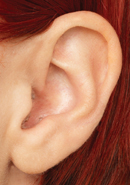Different hearing aid styles accommodate patients who experience varying levels of hearing loss. These devices are custom made to fit all ear types, offering an expected level of comfort with vast features. Hearing Wellness Centre offers a variety of these hearing aid styles, from the top manufacturers in the industry. With the latest technology, patients have a choice on how they choose to improve hearing.
When selecting a style the following is considered:
- The degree of the hearing loss (power requirements)
- Manual dexterity and visual abilities
- Patient budget
- Cosmetics
- Skin sensitivities
- Anatomical/medical considerations
- Lifestyle and listening needs
Style Breakdown
Discreet styles offer privacy, while quality of life improvements favor larger devices. Whatever choice is made, better hearing is the core of all styles represented. Finding the right combination of style and features takes time, but is well worth the time.
In the ear (ITE)
In the ear is a slight step down from BTE when comparing size. Instead of a separate unit behind the ear, the entire hearing aid rests within the outer portion of the ear. There are a lot of power features included with ITE devices, including manual access to important settings. A nice set of color and design options adds a little personality to the available models in this category.

Invisible in canal (IIC)
IIC devices are custom-made and are the smallest types you can get when privacy is a concern. The majority of IIC pairs are disposable, so switching out the battery is not a concern. They have a long life and an interesting set of sound enhancement features. IIC is most typically recommended for individuals with mild hearing loss.

Completely in canal (CIC)
Completely in the canal is sometimes confused for ITC due to similarities in design. CIC is slightly smaller than ITC but maintains a lot of the core features. With this style, wearers get power features in a hearing aid that does a good job of hiding. Because of the size, accessing controls manually can be difficult. CIC devices that come with a smartphone app can resolve this issue.

In the canal (ITC)
When wearers need the size of IIC but the features of BTE, then ITC devices are a good compromise. They are a little bigger than IIC, but still rest firmly in the canal. They maintain a fair level of privacy while wearing them out in public. The big gain from using ITC is that it handles severe hearing loss well.

Full shell in the ear (ITE)
Full shell models sit flush within the entire ear bowl. Their size allows the maximum number of additional controls and features such as directional microphones, which require space on the outer portion of the instrument. They use a larger battery size than the smaller styles and can fit a larger receiver with enough power for even some severe hearing losses. Because of their flexibility, they’re widely recommended for mild-to-severe hearing loss.
Behind the ear
This is the most common style in the industry. This is also one of the largest types of hearing aids, which offers wearers more power and handling capabilities. There are also mini BTE options, as well as varieties available in skin and hair tones to provide more discreetness if that’s what you’re looking for. BTE is more likely to carry power features for individuals with mild-to-profound hearing loss.

Mini BTE with slim tube and tip
Mini BTEs are designed to hide behind the outer ear and have ultra-thin tubing/wiring to discreetly route sound into the ear. The tubing/wiring connects to a soft tip that sits in the ear canal but doesn’t occlude it. The result is a natural, open feeling as airflow and sound enter the ear naturally around the tip, while amplified sound enters through the tip. This is known as “open fitting” and is recommended for mild-to-moderate high frequency losses.

Receiver in canal (RIC)
RIC models are mini BTEs that have the speaker of the instrument incorporated in the ear tip, instead of in the main body of the instrument. RIC instruments fit mild-to-severe hearing losses. This hearing aid style looks similar to the Mini BTE when worn on the ear.

BTE with Earmold
BTEs with earmolds fit mild through severe hearing losses. Their longer shape follows the contour behind the outer ear and can house many features, including a program button and volume control. The earmold color and style, as well as the wearer’s hairstyle, determine exactly how they’ll look on each person.
Choosing the right one
When it comes to choosing the right hearing aids for you, there are several things you should consider, including your lifestyle, hearing loss and budget needs. This is why it’s important to rely on the help of an audiologist, who can fully educate you on the pros and cons of each device style, as well as how they may fit into your life.
